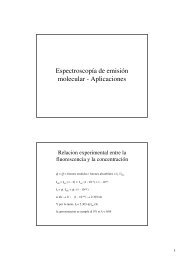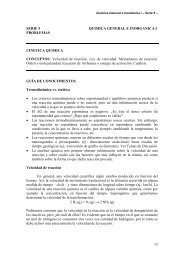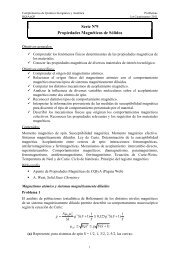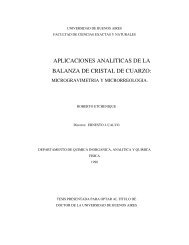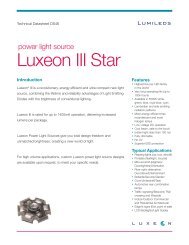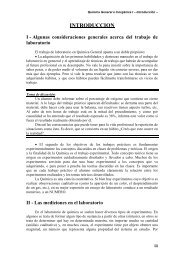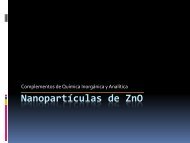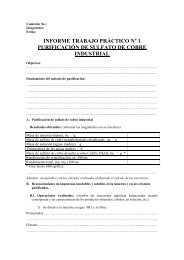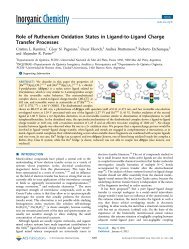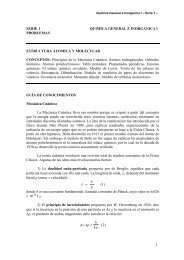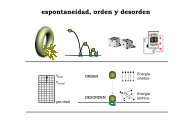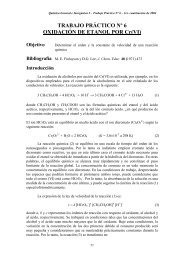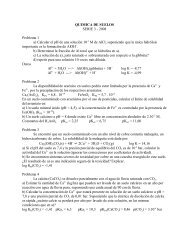Synthesis of brookite TiO2 nanoparticles by thermolysis of TiCl4 in ...
Synthesis of brookite TiO2 nanoparticles by thermolysis of TiCl4 in ...
Synthesis of brookite TiO2 nanoparticles by thermolysis of TiCl4 in ...
You also want an ePaper? Increase the reach of your titles
YUMPU automatically turns print PDFs into web optimized ePapers that Google loves.
<strong>Synthesis</strong> <strong>of</strong> <strong>brookite</strong> TiO 2 <strong>nanoparticles</strong> <strong>by</strong> <strong>thermolysis</strong> <strong>of</strong> TiCl 4 <strong>in</strong><br />
strongly acidic aqueous media<br />
Agnès Pottier, a Cor<strong>in</strong>ne Chanéac, a Elisabeth Tronc, a Léo Mazerolles b and<br />
Jean-Pierre Jolivet* a<br />
a Chimie de la Matière Condensée, UMR-CNRS 7574, Université P. et M. Curie, 4 place<br />
Jussieu, 75252 Paris, Cedex 05, France. E-mail: jpj@ccr.jussieu.fr<br />
b CECM - CNRS, 15 rue G. Urba<strong>in</strong>, 94407 Vitry, Cedex, France<br />
Received 11th January 2001, Accepted 24th January 2001<br />
First published as an Advance Article on the web 5th March 2001<br />
Nanometric particles <strong>of</strong> titania, <strong>brookite</strong> and rutile polymorphs were synthesised <strong>by</strong> <strong>thermolysis</strong> <strong>of</strong> TiCl 4 <strong>in</strong><br />
concentrated HCl solutions. The Cl : Ti molar ratio seems to be the key factor <strong>in</strong> determ<strong>in</strong><strong>in</strong>g the crystall<strong>in</strong>e<br />
phases and their relative proportions as well as the particle size and a large proportion <strong>of</strong> <strong>brookite</strong> can be<br />
obta<strong>in</strong>ed under specific conditions. The complex Ti(OH) 2 (Cl) 2 (OH 2 ) 2 seems to be the precursor <strong>of</strong> the <strong>brookite</strong><br />
phase. The presence <strong>of</strong> chloride ions is also necessary to stabilise <strong>brookite</strong> <strong>in</strong> suspension. Depend<strong>in</strong>g on the<br />
acidity and the age<strong>in</strong>g conditions, different morphologies <strong>of</strong> <strong>brookite</strong> <strong>nanoparticles</strong> are obta<strong>in</strong>ed, namely<br />
spheroidal particles or platelets. Stable sols <strong>of</strong> pure <strong>brookite</strong> are obta<strong>in</strong>ed <strong>by</strong> peptization <strong>of</strong> the solid phase.<br />
Introduction<br />
Titanium dioxide is used largely <strong>in</strong> technological applications.<br />
1–6 Its current use is as a white pigment for pa<strong>in</strong>ts or<br />
cosmetics, as a support <strong>in</strong> catalysis and as a photocatalyst.<br />
Titanium dioxide is also a common material for photovoltaic<br />
cells and appears to be <strong>in</strong>terest<strong>in</strong>g as a dielectric material for<br />
the next generation <strong>of</strong> ultra-th<strong>in</strong> capacitors due to its high<br />
dielectric constant. 7 The uses and performances for a given<br />
application are, however, strongly <strong>in</strong>fluenced <strong>by</strong> the crystall<strong>in</strong>e<br />
structure, the morphology and the size <strong>of</strong> the particles. 8–12<br />
Indeed, as for many other solids, nanosized TiO 2 particles are<br />
<strong>of</strong> particular <strong>in</strong>terest because <strong>of</strong> their specifically size-related<br />
properties. Hence, many works have focussed on the synthesis<br />
<strong>of</strong> titanium dioxide <strong>nanoparticles</strong>. 13–24<br />
Anatase and rutile are the polymorphs <strong>of</strong> TiO 2 commonly<br />
obta<strong>in</strong>ed <strong>by</strong> hydrolysis <strong>of</strong> titanium compounds, such as<br />
titanium tetrachloride (TiCl 4 ) 13–15 or titanium alkoxides<br />
(Ti(OR) 4 ), <strong>in</strong> solution. 16–19 Brookite is sometimes observed<br />
as a <strong>by</strong>-product when the precipitation is carried out <strong>in</strong> an<br />
acidic medium at low temperature. 17,18,20,21 It is also observed<br />
after a 15 month period <strong>of</strong> age<strong>in</strong>g for a precipitate formed from<br />
TiCl 4 and ammonia. 22 Classically, <strong>brookite</strong> is obta<strong>in</strong>ed as large<br />
crystals <strong>by</strong> hydrothermal methods at high temperature and<br />
pressure (200¡T¡400 ‡C, 10¡P¡400 bar) <strong>in</strong> aqueous 23 or <strong>in</strong><br />
organic media. 24 In this latter case, particular amounts <strong>of</strong><br />
sodium cations <strong>in</strong> the reaction medium seem necessary to<br />
produce pure <strong>brookite</strong>.<br />
We report a study <strong>of</strong> the <strong>thermolysis</strong> at 100 ‡C <strong>of</strong> titanium<br />
tetrachloride <strong>in</strong> concentrated hydrochloric acid, show<strong>in</strong>g that<br />
<strong>brookite</strong> can be obta<strong>in</strong>ed, under precise conditions <strong>of</strong><br />
precipitation, quasi-quantitatively as <strong>nanoparticles</strong>. The <strong>in</strong>fluence<br />
<strong>of</strong> the physico-chemical conditions (acidity <strong>of</strong> the medium,<br />
nature <strong>of</strong> the anions, age<strong>in</strong>g <strong>of</strong> suspensions) on the <strong>brookite</strong><br />
formation was <strong>in</strong>vestigated. The morphology and size <strong>of</strong><br />
particles were also studied. To our knowledge, this is the first<br />
report <strong>of</strong> quasi-quantitative formation <strong>of</strong> <strong>brookite</strong> <strong>nanoparticles</strong><br />
<strong>in</strong> an aqueous medium without strong complex<strong>in</strong>g agents<br />
and <strong>in</strong> non-hydrothermal conditions.<br />
Experimental<br />
<strong>Synthesis</strong><br />
TiO 2 particles were formed <strong>by</strong> add<strong>in</strong>g 1 mL <strong>of</strong> pure TiCl 4<br />
dropwise to 50 mL (150 or 20 mL) <strong>of</strong> hydrochloric or<br />
perchloric acid, the concentration <strong>of</strong> the acid was varied<br />
between 1 and 5 mol dm 23 . The f<strong>in</strong>al titanium concentration <strong>in</strong><br />
the mixtures was 0.15 mol dm 23 (0.05 and 0.4 mol dm 23 ,<br />
respectively). The solutions were heated and aged at 100 ‡C <strong>in</strong><br />
an oven. Some syntheses were carried out <strong>in</strong> the presence <strong>of</strong><br />
NaCl at various concentrations.<br />
All syntheses were performed <strong>in</strong> glass or Nalgene bottles<br />
which had been carefully cleaned with concentrated hydrochloric<br />
acid and distilled water <strong>in</strong> order to avoid the presence <strong>of</strong><br />
sources <strong>of</strong> nucleation able to <strong>in</strong>fluence the crystall<strong>in</strong>e structure<br />
<strong>of</strong> the precipitate.<br />
After age<strong>in</strong>g, the solid was centrifuged, washed with distilled<br />
water and dried under a nitrogen atmosphere. In the syntheses<br />
yield<strong>in</strong>g a mixture <strong>of</strong> <strong>brookite</strong> and rutile, the selective<br />
peptization <strong>of</strong> <strong>brookite</strong> <strong>in</strong> acidic media was carried out as<br />
follows. The solid collected after centrifugation was treated<br />
with a HNO 3 solution (3 mol dm 23 ) over ca. 20 m<strong>in</strong>. The<br />
suspension was aga<strong>in</strong> centrifuged and the recovered solid phase<br />
was dispersed <strong>in</strong> water (the pH <strong>of</strong> the f<strong>in</strong>al suspension was<br />
around 1.5) and centrifuged aga<strong>in</strong>. After this last centrifugation,<br />
the supernatant phase conta<strong>in</strong>ed only <strong>brookite</strong> particles<br />
while the rutile particles formed the precipitate. A portion <strong>of</strong><br />
the sol was diluted for transmission electron microscopy and<br />
quasi-elastic light scatter<strong>in</strong>g measurements; another was dried<br />
at room temperature for X-ray diffraction characterization.<br />
Techniques<br />
X-Ray diffraction. XRD patterns were obta<strong>in</strong>ed us<strong>in</strong>g a<br />
powder diffractometer (Philips PW1830) operat<strong>in</strong>g <strong>in</strong> the<br />
reflection mode with CuKa radiation and equipped with a<br />
graphite back monochromator. The angular doma<strong>in</strong> was<br />
between 20 and 80‡ (2h). The patterns were analysed us<strong>in</strong>g<br />
the Philips PC APD 3.5 program package. The proportions <strong>of</strong><br />
1116 J. Mater. Chem., 2001, 11, 1116–1121 DOI: 10.1039/b100435m<br />
This journal is # The Royal Society <strong>of</strong> Chemistry 2001
the different titanium dioxide polymorphs (anatase, <strong>brookite</strong>,<br />
rutile) <strong>in</strong> the solids were evaluated from the relative areas <strong>of</strong> the<br />
110, 121 and 101 diffraction l<strong>in</strong>es <strong>of</strong> rutile, <strong>brookite</strong> and<br />
anatase phases, respectively. Calibrations were performed<br />
us<strong>in</strong>g particles <strong>of</strong> rutile (8 nm <strong>in</strong> mean diameter) and <strong>of</strong><br />
anatase (10 nm mean diameter) obta<strong>in</strong>ed <strong>by</strong> <strong>thermolysis</strong> at<br />
100 ‡C <strong>of</strong> TiCl 4 (0.15 mol dm 23 ) <strong>in</strong> HClO 4 (5 mol dm 23 ) and <strong>in</strong><br />
a mixture <strong>of</strong> HCl (1 mol dm 23 ) and Na 2 SO 4 (1 mol dm 23 ),<br />
respectively. Brookite particles are those synthesised and<br />
purified <strong>by</strong> the procedure described above.<br />
Transmission electron microscopy (TEM). Transmission<br />
electron micrographs were obta<strong>in</strong>ed us<strong>in</strong>g a JEOL 100 CX II<br />
apparatus. Samples were prepared <strong>by</strong> evaporat<strong>in</strong>g very dilute<br />
suspensions onto carbon-coated grids. The d-spac<strong>in</strong>gs were<br />
calibrated us<strong>in</strong>g the gold pattern. Particle size distributions<br />
were determ<strong>in</strong>ed <strong>by</strong> measur<strong>in</strong>g the average diameter <strong>of</strong> ca. 100<br />
particles.<br />
High-resolution transmission electron microscopy (HR-<br />
TEM). Observations were performed with a TOPCON 002B<br />
microscope operat<strong>in</strong>g at 200 kV. The high-resolution (HR)<br />
images were digitized us<strong>in</strong>g a charge-coupled video camera<br />
device mounted above a light box. The fr<strong>in</strong>ge spac<strong>in</strong>gs were<br />
measured from the position <strong>of</strong> the Bragg peaks <strong>in</strong> the Fourier<br />
transform <strong>of</strong> the images.<br />
Quasi-elastic light scatter<strong>in</strong>g (QELS). Measurements were<br />
performed on stable suspensions us<strong>in</strong>g an AMTEC SM 200<br />
apparatus equipped with a He–Ne laser beam and a<br />
Brookhaven Bi2030 correlator.<br />
Titration <strong>of</strong> titaniun. Titanium concentrations were determ<strong>in</strong>ed<br />
<strong>by</strong> colorimetry <strong>of</strong> the very stable, coloured complex<br />
formed <strong>in</strong> solution <strong>by</strong> Ti 4z ions with H 2 O 2 . 25,26 The Ti 4z<br />
solutions were diluted <strong>in</strong> hydrochloric acid (1 mol dm 23 )to<br />
obta<strong>in</strong> a concentration between 2610 24 and<br />
2610 23 mol dm 23 . A 1 mL sample <strong>of</strong> this solution was then<br />
added to 3 mL <strong>of</strong> a H 2 O 2 solution (10% <strong>by</strong> volume).<br />
Measurements were performed us<strong>in</strong>g an Uvikon 940 spectrometer.<br />
The titration <strong>of</strong> titanium <strong>in</strong> solid samples was carried<br />
out follow<strong>in</strong>g the same method. The solid was first isolated<br />
from the liquid <strong>by</strong> centrifugation and then dissolved <strong>in</strong> hot,<br />
concentrated sulfuric acid <strong>in</strong> the presence <strong>of</strong> ammonium<br />
sulfate.<br />
Specific surface measurements. Specific surface areas were<br />
determ<strong>in</strong>ed us<strong>in</strong>g an ASAP 2010 Micromeritics apparatus<br />
follow<strong>in</strong>g the BET analysis. Adsorption and desorption <strong>of</strong> N 2<br />
were performed at 77 K. Samples had been previously outgassed<br />
<strong>by</strong> heat<strong>in</strong>g at 100 ‡C under vacuum (3 mm Hg).<br />
Results<br />
Thermolysis <strong>of</strong> TiCl 4 <strong>in</strong> hydrochloric acid<br />
The XRD pattern <strong>of</strong> the solid formed after thermolys<strong>in</strong>g a<br />
TiCl 4 solution ([Ti]~0.15 mol dm 23 , [HCl]~3 mol dm 23 ) for<br />
48 h [Fig. 1(a)] shows that the two polymorphs <strong>of</strong> TiO 2 ,<br />
<strong>brookite</strong> and rutile, are present. TEM micrographs show<br />
particles <strong>of</strong> very dist<strong>in</strong>ct morphologies [Fig. 1(b)] which were<br />
identified <strong>by</strong> electron diffraction as rutile, for the elongated<br />
particles, and <strong>brookite</strong>, for the small, spheroidal aggregates.<br />
The proportion <strong>of</strong> <strong>brookite</strong> (evaluated from the XRD pattern)<br />
is ca. 80% <strong>of</strong> the mixture. The relative proportions <strong>of</strong> <strong>brookite</strong><br />
and rutile do not vary beyond 48 h <strong>of</strong> age<strong>in</strong>g at 100 ‡C, but they<br />
are markedly dependent on the acidity <strong>of</strong> the medium and the<br />
concentration <strong>of</strong> titanium. For [Ti]~0.15 mol dm 23 , <strong>brookite</strong><br />
is the ma<strong>in</strong> phase (ca. 70–80%) obta<strong>in</strong>ed for the acidity range <strong>of</strong><br />
2¡[HCl]¡4 mol dm 23 [Fig. 2(b)]. At [Ti]~0.05 mol dm 23 ,<br />
Fig. 1 XRD pattern (a) and TEM micrograph (b) <strong>of</strong> the solid obta<strong>in</strong>ed<br />
<strong>by</strong> thermolys<strong>in</strong>g a solution <strong>of</strong> TiCl 4 (0.15 mol dm 23 ) <strong>in</strong> HCl<br />
(3 mol dm 23 ) at 100 ‡C for 48 h. The peaks are <strong>brookite</strong> ($) and<br />
rutile (#).<br />
70% <strong>of</strong> the solid crystallises as <strong>brookite</strong> whatever the acidity,<br />
but at [Ti]~0.4 mol dm 23 , only rutile is obta<strong>in</strong>ed <strong>in</strong><br />
1 mol dm 23 HCl and 5 mol dm 23 HCl [Fig. 2(a), 2(c)].<br />
The k<strong>in</strong>etics <strong>of</strong> precipitation are also very dependent on the<br />
acidity and the concentration <strong>of</strong> titanium. The rate is always<br />
slowed strongly as the acidity <strong>of</strong> the medium is <strong>in</strong>creased. At<br />
[Ti]~0.15 mol dm 23 , no solid is recovered <strong>by</strong> centrifugation up<br />
to 5 h <strong>of</strong> <strong>thermolysis</strong>. After 24 h <strong>in</strong> 1 mol dm 23 HCl, no<br />
titanium is titrated <strong>in</strong> the supernatant solution <strong>in</strong>dicat<strong>in</strong>g that<br />
the precipitation is complete, but <strong>in</strong> 5 mol dm 23 HCl, ca. 70%<br />
<strong>of</strong> titanium is still present as soluble complexes. In order to<br />
achieve the precipitation <strong>in</strong> the latter case, a 48 h <strong>thermolysis</strong><br />
period is needed. It is also <strong>in</strong>terest<strong>in</strong>g to note that the third<br />
polymorph <strong>of</strong> TiO 2 , anatase, is formed <strong>in</strong> small amounts (from<br />
10 to 20%) <strong>in</strong> the early stages <strong>of</strong> precipitation (after 5 h), as<br />
shown <strong>by</strong> XRD (Fig. 3), but disappears afterwards to yield<br />
only rutile and/or <strong>brookite</strong> (Fig. 1).<br />
The particles <strong>of</strong> <strong>brookite</strong> have been characterised after<br />
different durations <strong>of</strong> <strong>thermolysis</strong> and separation from rutile <strong>by</strong><br />
peptization with nitric acid (see Experimental). The difference<br />
<strong>in</strong> size <strong>of</strong> the two types <strong>of</strong> particles [Fig. 1(b)] expla<strong>in</strong>s their<br />
difference <strong>in</strong> peptizability. The XRD pattern <strong>of</strong> the solid<br />
recovered <strong>by</strong> dry<strong>in</strong>g the sol is characteristic <strong>of</strong> pure <strong>brookite</strong><br />
(Fig. 4). After 48 h <strong>of</strong> <strong>thermolysis</strong>, TEM micrographs show<br />
primary particles <strong>of</strong> mean size 5.2 nm (standard deviation,<br />
s~1.4 nm) strongly aggregated [Fig. 5(a)]. The size <strong>of</strong> the<br />
aggregates varies from 40 to 60 nm, <strong>in</strong> accordance with the<br />
results <strong>of</strong> QELS measurements [Fig. 5(b)]. After one month <strong>of</strong><br />
<strong>thermolysis</strong>, the mean size <strong>of</strong> the aggregates does not change<br />
significantly. BET measurements also show that the specific<br />
area <strong>of</strong> <strong>brookite</strong> particles does not evolve significantly dur<strong>in</strong>g<br />
age<strong>in</strong>g (97 and 117 m 2 g 21 for particles formed after 2 days and<br />
one month, respectively). However, the mean particle size<br />
with<strong>in</strong> the aggregates evaluated from TEM, D~12.1 nm<br />
(s~2 nm), is notably <strong>in</strong>creased, suggest<strong>in</strong>g that recrystallisation<br />
<strong>of</strong> the early particles has occurred <strong>in</strong>side the aggregates<br />
dur<strong>in</strong>g age<strong>in</strong>g [Fig. 5(c)]. HRTEM micrographs show well-<br />
J. Mater. Chem., 2001, 11, 1116–1121 1117
Fig. 3 XRD patterns <strong>of</strong> solids obta<strong>in</strong>ed <strong>by</strong> thermolys<strong>in</strong>g a solution <strong>of</strong><br />
TiCl 4 (0.15 mol dm 23 ) (a) <strong>in</strong> [HCl]~1 mol dm 23 and (b) 3 mol dm 23 at<br />
100 ‡C for 5 h; A~anatase, B~<strong>brookite</strong>, R~rutile.<br />
but after one month <strong>of</strong> age<strong>in</strong>g at 100 ‡C, rutile is the only solid<br />
component for the whole acidity range studied.<br />
Fig. 2 Relative proportions <strong>of</strong> <strong>brookite</strong> ($) and rutile (#) formed <strong>by</strong><br />
thermolys<strong>in</strong>g a solution <strong>of</strong> TiCl 4 at 0.05 mol dm 23 (a), 0.15 mol dm 23<br />
(b) and 0.4 mol dm 23 (c) <strong>in</strong> HCl medium at 100 ‡C for 48 h.<br />
def<strong>in</strong>ed, diamond-shaped platelets form<strong>in</strong>g an ordered stack<strong>in</strong>g<br />
as suggested <strong>by</strong> the same orientation <strong>of</strong> atomic planes with<strong>in</strong><br />
adjacent particles [Fig. 6(a), 6(b)]. The <strong>in</strong>set <strong>of</strong> Fig. 6 shows the<br />
numerical local diffraction correspond<strong>in</strong>g to the amplitude <strong>of</strong><br />
the Fourier transform <strong>of</strong> the HR image. Assignment <strong>of</strong> this<br />
electron diffraction pattern [Fig. 6(b)] <strong>in</strong>dicates that these two<br />
families <strong>of</strong> planes correspond to [1 21 21] and [1 1 21] planes<br />
with d-spac<strong>in</strong>g <strong>of</strong> 0.34 nm. These planes, form<strong>in</strong>g between them<br />
an angle <strong>of</strong> 79‡, are exactly parallel to the sides <strong>of</strong> particles and<br />
correspond <strong>in</strong> all likelihood to the lateral faces <strong>of</strong> the particles.<br />
As a consequence, the basal faces <strong>of</strong> the particles could<br />
correspond to the [3 0 1] plane which is quasi-perpendicular<br />
(91‡) to both the [1 21 21] and [1 1 21] planes. When the<br />
precipitation is very slow ([Ti]~0.05 mol dm 23 ,<br />
[HCl]~5 mol dm 23 ) similar diamond-shaped but larger platelets<br />
<strong>of</strong> <strong>brookite</strong>, mean size 40 nm, are formed after one month<br />
<strong>of</strong> <strong>thermolysis</strong>. At this stage, the precipitation is almost<br />
complete.<br />
Influence <strong>of</strong> the chloride ions on the formation <strong>of</strong> <strong>brookite</strong><br />
The forego<strong>in</strong>g results show that the acidity <strong>of</strong> the medium and<br />
the nature <strong>of</strong> anions strongly <strong>in</strong>fluence the crystall<strong>in</strong>e structure<br />
<strong>of</strong> titania particles formed upon <strong>thermolysis</strong>. In concentrated<br />
perchloric acid solutions, perchlorate ions can be coord<strong>in</strong>ated<br />
to the Ti(IV) cation but the complexes are not very stable 27 and<br />
consequently perchlorate does not seem to have a specific role<br />
<strong>in</strong> the crystallisation <strong>of</strong> titania. On the other hand, the chloride<br />
ions seem to be essential for the formation <strong>of</strong> <strong>brookite</strong>. The<br />
<strong>in</strong>fluence <strong>of</strong> the chloride ion was <strong>in</strong>vestigated <strong>by</strong> carry<strong>in</strong>g out<br />
the <strong>thermolysis</strong> <strong>of</strong> TiCl 4 <strong>in</strong> hydrochloric acid ([HCl]~1 to<br />
5 mol dm 23 , [Ti]~0.15 mol dm 23 ) <strong>in</strong> the presence <strong>of</strong> various<br />
amounts <strong>of</strong> NaCl. In this manner, the Cl : Ti ratio can be varied<br />
Thermolysis <strong>of</strong> TiCl 4 <strong>in</strong> perchloric acid<br />
In the range <strong>of</strong> 1¡[HClO 4 ]¡5 mol dm 23 , the precipitation <strong>of</strong><br />
titanium ions is complete after 24 h <strong>of</strong> <strong>thermolysis</strong>, whatever<br />
the acidity <strong>of</strong> the medium. Brookite, anatase and ma<strong>in</strong>ly rutile<br />
are precipitated simultaneously at the beg<strong>in</strong>n<strong>in</strong>g <strong>of</strong> <strong>thermolysis</strong>,<br />
Fig. 4 XRD pattern <strong>of</strong> <strong>brookite</strong> particles result<strong>in</strong>g from the fractionation<br />
<strong>of</strong> the precipitate formed <strong>by</strong> <strong>thermolysis</strong> <strong>of</strong> a solution <strong>of</strong> TiCl 4<br />
(0.15 mol dm 23 ) <strong>in</strong> HCl (3 mol dm 23 ) at 100 ‡C for 48 h.<br />
1118 J. Mater. Chem., 2001, 11, 1116–1121
Fig. 7 Fraction <strong>of</strong> <strong>brookite</strong> <strong>in</strong> the precipitate (a) and fraction <strong>of</strong> soluble<br />
species <strong>of</strong> titanium (b) after 24 h <strong>of</strong> <strong>thermolysis</strong> for TiCl 4<br />
(0.15 mol dm 23 ) <strong>in</strong> HCl medium <strong>in</strong> the presence <strong>of</strong> NaCl at different<br />
concentrations.<br />
Fig. 5 Particles <strong>of</strong> <strong>brookite</strong> separated from rutile <strong>by</strong> peptization after<br />
thermolys<strong>in</strong>g a solution <strong>of</strong> TiCl 4 (0.15 mol dm 23 ) <strong>in</strong> HCl (3 mol dm 23 )<br />
at 100 ‡C. TEM micrograph (a) and hydrodynamic particle size<br />
distribution (b) after 48 h <strong>of</strong> <strong>thermolysis</strong>; TEM micrograph <strong>of</strong> particles<br />
after one month <strong>of</strong> <strong>thermolysis</strong> (c).<br />
over a large range, <strong>in</strong>dependently <strong>of</strong> the acidity <strong>of</strong> the medium.<br />
The results are summarised <strong>in</strong> Fig. 7. For [HCl]w2 mol dm 23 ,<br />
the <strong>in</strong>crease <strong>of</strong> Cl 2 concentration strongly decreases the<br />
relative proportion <strong>of</strong> <strong>brookite</strong> <strong>in</strong> the solid phase and the<br />
amount <strong>of</strong> the solid after 24 h <strong>of</strong> <strong>thermolysis</strong> [Fig. 7(a), 7(b)].<br />
The specific role <strong>of</strong> chloride ions is also well evidenced <strong>in</strong> Fig. 8<br />
which represents the relative proportions <strong>of</strong> titanium (as rutile,<br />
<strong>brookite</strong> and soluble species) as a function <strong>of</strong> the Cl total :Ti<br />
ratio. This diagram shows that the optimal range for the<br />
formation <strong>of</strong> <strong>brookite</strong> (proportion above 50%) corresponds to<br />
aCl total : Ti ratio rang<strong>in</strong>g between 17 and 35. The Cl total :Ti<br />
ratio seems to be the pert<strong>in</strong>ent parameter s<strong>in</strong>ce the proportions<br />
reported <strong>in</strong> Fig. 8 do not depend on the various [NaCl]z[HCl]<br />
comb<strong>in</strong>ations correspond<strong>in</strong>g to the same Cl total : Ti ratio.<br />
Provided that chloride ions are present <strong>in</strong> the suspension,<br />
particles <strong>of</strong> <strong>brookite</strong> are stable aga<strong>in</strong>st recrystallisation to rutile<br />
for a long period <strong>of</strong> <strong>thermolysis</strong>. Particles <strong>of</strong> <strong>brookite</strong> formed <strong>in</strong><br />
Fig. 6 HRTEM micrographs <strong>of</strong> particles <strong>of</strong> <strong>brookite</strong> separated from<br />
rutile <strong>by</strong> peptization after one month <strong>of</strong> <strong>thermolysis</strong> at 100 ‡C (TiCl 4<br />
0.15 mol dm 23 , HCl 3 mol dm 23 ); <strong>in</strong>set, the local electron diffraction<br />
pattern.<br />
Fig. 8 Proportion <strong>of</strong> titanium as soluble complexes (6) and as solid<br />
forms (<strong>brookite</strong> $, and rutile #) as a function <strong>of</strong> the Cl total : Ti ratio<br />
after 24 h <strong>of</strong> <strong>thermolysis</strong> at 100 ‡C for TiCl 4 .<br />
J. Mater. Chem., 2001, 11, 1116–1121 1119
Fig. 9 XRD patterns <strong>of</strong> solids obta<strong>in</strong>ed after age<strong>in</strong>g <strong>brookite</strong> particles<br />
<strong>in</strong> HClO 4 (3 mol dm 23 ) for 1 month at 100 ‡C (a) and <strong>in</strong> the equimolar<br />
mixture <strong>of</strong> HClO 4 and NaCl (3 mol dm 23 ) (b). [Brookite particles are<br />
<strong>in</strong>itially formed <strong>by</strong> <strong>thermolysis</strong> <strong>of</strong> TiCl 4 (0.15 mol dm 23 ) <strong>in</strong> HCl<br />
(3 mol dm 23 ) for 24 h at 100 ‡C.]<br />
Fig. 10 Possible reaction pathway for <strong>brookite</strong> formation from the<br />
[Ti(OH) 2 Cl 2 (OH 2 ) 2 ] 0 complex.<br />
3 mol dm 23 HCl for 0.15 mol dm 23 Ti, and then transferred<br />
<strong>in</strong>to 1 mol dm 23 or 6 mol dm 23 HCl and aged at 100 ‡C for one<br />
month, did not change their crystall<strong>in</strong>e structure or size. On the<br />
other hand, <strong>brookite</strong> particles aged at 100 ‡C <strong>in</strong> 3 mol dm 23<br />
perchloric acid led to quasi-quantitative transformation <strong>in</strong>to<br />
rutile particles [Fig. 9(a)], suggest<strong>in</strong>g a dissolution–crystallisation<br />
process for the transformation. However, if the age<strong>in</strong>g<br />
was carried out <strong>in</strong> 3 mol dm 23 perchloric acid conta<strong>in</strong><strong>in</strong>g<br />
3 mol dm 23 NaCl, no modification <strong>of</strong> the <strong>brookite</strong> proportion<br />
or <strong>of</strong> the particle shape occurred [Fig. 9(b)].<br />
Discussion<br />
A high concentration <strong>of</strong> chloride ions <strong>in</strong> the <strong>thermolysis</strong><br />
medium <strong>of</strong> titanium appears to be necessary for the formation<br />
<strong>of</strong> <strong>brookite</strong> and also to avoid recrystallisation <strong>of</strong> <strong>brookite</strong> <strong>in</strong>to<br />
rutile dur<strong>in</strong>g age<strong>in</strong>g <strong>in</strong> suspension. As this transformation<br />
proceeds <strong>by</strong> dissolution–crystallisation because <strong>of</strong> the large<br />
changes <strong>in</strong> the size and morphology <strong>of</strong> particles, complexation<br />
<strong>of</strong> titanium ions <strong>in</strong> solution <strong>by</strong> chloride must be very likely<br />
<strong>in</strong>volved.<br />
The speciation <strong>of</strong> titanium hydroxochloro complexes at low<br />
concentration <strong>of</strong> titanium, <strong>in</strong> order to avoid precipitation, has<br />
been <strong>in</strong>vestigated <strong>by</strong> Nabivanets and Kudritskaya 28–30 Upon<br />
<strong>in</strong>creas<strong>in</strong>g the concentration <strong>of</strong> chloride ions <strong>in</strong> strongly acidic<br />
media at elevated ionic strength, the complexes [Ti(O-<br />
H) 2 (OH 2 ) 4 ] 2z , [Ti(OH) 2 Cl(OH 2 ) 3 ] z (b 1 ~3.55), [Ti(OH) 2-<br />
Cl 2 (OH 2 ) 2 ] 0 (b 2 ~0.40), [Ti(OH) 2 Cl 3 (OH 2 )] 2 (b 3 ~0.094), and<br />
[Ti(OH) 2 Cl 4 ] 22 (b 4 ~0.083) are successively formed. The Cl : Ti<br />
ratio comb<strong>in</strong>ed <strong>in</strong> the complexes seems to depend only upon<br />
the Cl : Ti ratio <strong>in</strong> solution. Consequently, it is very likely that<br />
the <strong>thermolysis</strong> <strong>of</strong> a complex [Ti(OH) a Cl b (OH 2 ) 62a2b ] (42a2b)z<br />
leads only to the progressive <strong>in</strong>crease <strong>of</strong> hydroxylation ratio<br />
HO : Ti, from a~1 uptoa~42b, a value correspond<strong>in</strong>g to the<br />
non-electrically charged complex allow<strong>in</strong>g the precipitation <strong>of</strong><br />
solid. It is then <strong>in</strong>terest<strong>in</strong>g to observe that <strong>brookite</strong> is the major<br />
phase obta<strong>in</strong>ed <strong>in</strong> the range 17¡Cl : Ti¡35, with<br />
[Ti]~0.15 mol dm 23 (Fig. 8). This range corresponds to that<br />
where the non-electrically charged complex [Ti(OH) 2-<br />
Cl 2 (OH 2 ) 2 ] 0 predom<strong>in</strong>ates <strong>in</strong> dilute titanium solution<br />
(0.40¡log[Cl 2 ]¡0.65). 30 This strongly suggests that the<br />
complex [Ti(OH) 2 Cl 2 (OH 2 ) 2 ] 0 could be the precursor <strong>of</strong><br />
<strong>brookite</strong>.<br />
A schematic pathway is suggested to expla<strong>in</strong> the formation<br />
<strong>of</strong> <strong>brookite</strong> from the precursor [Ti(OH) 2 Cl 2 (OH 2 ) 2 ] 0 (Fig. 10).<br />
The presence <strong>of</strong> aquo and hydroxo ligands <strong>in</strong> the coord<strong>in</strong>ation<br />
sphere <strong>of</strong> this complex allows the condensation <strong>by</strong> olation,<br />
which <strong>in</strong>volves the elim<strong>in</strong>ation <strong>of</strong> aquo ligands (the chloride<br />
ions be<strong>in</strong>g more strongly bound groups), and the formation <strong>of</strong><br />
dimers and small cha<strong>in</strong>s <strong>of</strong> octahedra. When all water<br />
molecules are removed, further condensation will proceed <strong>by</strong><br />
oxolation reaction with HCl elim<strong>in</strong>ation and formation <strong>of</strong> m 3 -<br />
oxo bridges between octahedra (ab and abc structures <strong>in</strong><br />
Fig. 10). This process allows the removal <strong>of</strong> all chloride ions<br />
from the react<strong>in</strong>g species and yields oxide. Under such<br />
conditions, chloride ions act as templates. Their presence <strong>in</strong><br />
the coord<strong>in</strong>ation sphere <strong>of</strong> titanium ions orients the first steps<br />
<strong>of</strong> condensation but they are elim<strong>in</strong>ated only at the end <strong>of</strong> the<br />
process.<br />
Anionic complexes such as [Ti(OH) 2 Cl 3 (OH 2 )] 2 and<br />
[Ti(OH) 2 Cl 4 ] 22 predom<strong>in</strong>ate for Cl total :Ti¢40 (Fig. 8)<br />
([Ti]~0.05 mol dm 23 , [HCl]¢4 mol dm 23 ). The existence <strong>of</strong><br />
these complexes may expla<strong>in</strong> the high solubility <strong>of</strong> titanium and<br />
the lower<strong>in</strong>g <strong>of</strong> the rate <strong>of</strong> precipitation. By <strong>thermolysis</strong>, the<br />
elim<strong>in</strong>ation <strong>of</strong> a chloride ligand from the [Ti(OH) 2 Cl 3 (OH 2 )] 2<br />
complex forms the [Ti(OH) 2 Cl 2 (OH 2 ) 2 ] 0 complex which leads<br />
to <strong>brookite</strong> as described above. Under these conditions <strong>of</strong> very<br />
slow precipitation, large platelets <strong>of</strong> <strong>brookite</strong> are formed<br />
(Cl total :Ti¢60, Fig. 8). However, <strong>in</strong> very acidic media and with<br />
a high excess <strong>of</strong> chloride ions, the elim<strong>in</strong>ation <strong>of</strong> a hydroxo<br />
ligand with the formation <strong>of</strong> the [Ti(OH)Cl 3 (OH 2 ) 2 ] 0 complex<br />
may also occur. Dimerisation <strong>of</strong> this neutral complex likely<br />
proceeds <strong>by</strong> olation and forms bridg<strong>in</strong>g OH ligands, but<br />
further condensation must proceed <strong>by</strong> substitution <strong>of</strong> chloride<br />
ions, such a process lead<strong>in</strong>g to rutile (40¡Cl total :Tiv60,<br />
Fig. 8). These different complexes likely coexist <strong>in</strong> equilibrium<br />
and it is difficult to be precise on the respective roles <strong>of</strong> acidity<br />
and Cl : Ti ratio on the evolution <strong>of</strong> the soluble complexes<br />
dur<strong>in</strong>g <strong>thermolysis</strong>. Experimentally, we observe that the<br />
precipitation <strong>of</strong> titanium <strong>in</strong> the presence <strong>of</strong> an excess <strong>of</strong><br />
1120 J. Mater. Chem., 2001, 11, 1116–1121
NaCl leads to rutile, whereas at [Ti]~0.05 mol dm 23 and<br />
[HCl]¢3 mol dm 23 , the formation <strong>of</strong> <strong>brookite</strong> is favoured.<br />
Conclusion<br />
The crystall<strong>in</strong>e structure <strong>of</strong> titanium dioxide precipitated <strong>in</strong><br />
very acidic media seems to be controlled <strong>by</strong> the nature <strong>of</strong> the<br />
anions present <strong>in</strong> the precipitation medium. While it is well<br />
known that anatase is formed <strong>in</strong> the presence <strong>of</strong> sulfate anions,<br />
we have shown that chloride ions allow the quasi-quantitative<br />
formation <strong>of</strong> <strong>brookite</strong> dur<strong>in</strong>g <strong>thermolysis</strong> <strong>of</strong> very acidic<br />
solutions <strong>of</strong> TiCl 4 . In the presence <strong>of</strong> non-complex<strong>in</strong>g anions<br />
(i.e. perchlorate ions), rutile is the only isolated phase. The<br />
particles <strong>of</strong> <strong>brookite</strong> are well-def<strong>in</strong>ed, diamond-shaped platelets<br />
with a mean size depend<strong>in</strong>g on the acidity <strong>of</strong> the medium<br />
and/or the age<strong>in</strong>g time. Such nanometric particles <strong>of</strong> <strong>brookite</strong><br />
can be easily peptized <strong>in</strong> mild acidic solution and form stable<br />
sols.<br />
Acknowledgements<br />
We are grateful to Michel Lavergne (CRMP, Université P.et<br />
M. Curie) for electron microscopy measurements and to Dr<br />
François Ribot for fruitful discussions.<br />
References<br />
1 A. Fujishima and K. Honda, Nature, 1972, 238, 37.<br />
2 A. Chemsedd<strong>in</strong>e and H. P. Boehm, J. Mol. Cat., 1990, 60, 295.<br />
3 B. O. Regan and M. Graetzel, Nature, 1991, 353, 737.<br />
4 R. Wang, K. Hashimoto and A. Fujishima, Nature, 1997, 388, 431.<br />
5 A. E. Regazzoni, P. A. Mandelbaum, M. Matsuyochi, S. Schiller,<br />
S. A. Bilmes and M. A. Blesa, Langmuir, 1998, 14, 868.<br />
6 P. A. Mandelbaum, A. E. Regazzoni, M. A. Blesa and S. A. Bilmes,<br />
J. Phys. Chem. B, 1999, 103, 5505.<br />
7 R. J. Gonzalez, R. Zallen and H. Berger, Phys. Rev. B, 1997, 55,<br />
7014.<br />
8 Nanophase Materials, NATO ASI Series E 260, G. C. Hadjipanayis<br />
and R. W. Siegel, eds., Kluwer Academic Publishers, Dordrecht,<br />
1994.<br />
9 R. I. Bickley, T. Gonzalez-Carreno, J. S. Lees, L. Palmisano and<br />
R. J. D. Tilley, J. Solid State Chem., 1991, 92, 178.<br />
10 R. Krol, A. Goossens and J. Schoonman, J. Electrochem. Soc.,<br />
1997, 144, 1723.<br />
11 T. Moritz, J. Reiss, K. Diesner, D. Su and A. Chemsedd<strong>in</strong>e,<br />
J. Phys. Chem. B, 1997, 101, 8052.<br />
12 L. Kavan, M. Grätzel, S. E. Gilbert, C. Klemenz and H. Scheel,<br />
J. Am. Chem. Soc., 1996, 118, 6716.<br />
13 E. Santacesaria, M. Tonello, G. Storti, R. C. Pace and S. J. Carra,<br />
J. Colloid Interface Sci., 1986, 111, 44.<br />
14 E. Matijevic, M. Budnick and L. Meites, J. Colloid Interface Sci.,<br />
1977, 61, 302.<br />
15 L. I. Bekkerman, I. P. Dobrovol’skii and A. A. Ivak<strong>in</strong>, Russ.<br />
J. Inorg. Chem., 1976, 21, 223.<br />
16 A. Chemsedd<strong>in</strong>e and T. Moritz, Eur. J. Inorg. Chem., 1999, 2, 235.<br />
17 B. L. Bisch<strong>of</strong>f and M. A. Anderson, Chem. Mater., 1995, 7, 1772.<br />
18 P. Arnal, J. P. R. Corriu, D. Leclercq, P. H. Mut<strong>in</strong> and A. Vioux,<br />
J. Mater. Chem., 1996, 6, 1925.<br />
19 P. Arnal, J. P. R. Corriu, D. Leclercq, P. H. Mut<strong>in</strong> and A. Vioux,<br />
Chem. Mater., 1997, 9, 694.<br />
20 S. Music, M. Gotic, M. Ivanda, S. Popovic, A. Turkovic,<br />
R. Trojko, A. Sekulie and K. Furie, Mater. Sci. Eng., B, 1997,<br />
47, 33.<br />
21 X. Bokhimi, A. Morales, O. Novaro, T. Lopez, E. Sanchez and<br />
R. Gomez, J. Mater. Res., 1995, 10, 2788.<br />
22 J. P. Jalava, L. Heikkilä, O. Hovi, R. Laiho, E. Hiltunen,<br />
A. Hakanen and H. Härmä, Ind. Eng. Chem. Res., 1998, 37, 1317.<br />
23 I. Keesmann, Z. Anorg. Allg. Chem., 1966, 346, 31.<br />
24 H. Kom<strong>in</strong>ami, M. Kohno and Y. Kera, J. Mater. Chem., 2000, 10,<br />
1151.<br />
25 A. Weissler, Ind. Eng. Chem., 1945, 17, 695.<br />
26 G. Charlot, Les méthodes de la chimie analytique, Masson, Paris,<br />
1961.<br />
27 J. Beukenkamp and K. D. Herr<strong>in</strong>gton, J. Am. Chem. Soc., 1960,<br />
82, 3025.<br />
28 B. I. Nabivanets, Russ. J. Inorg. Chem., 1962, 7, 212.<br />
29 B. I. Nabivanets and L. N. Kudritskaya, Russ. J. Inorg. Chem.,<br />
1967, 12, 616.<br />
30 B. I. Nabivanets and L. N. Kudritskaya, Russ. J. Inorg. Chem.,<br />
1967, 12, 789.<br />
J. Mater. Chem., 2001, 11, 1116–1121 1121



